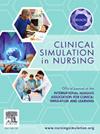Effectiveness of virtual reality in training operating room nurses for robotic arm surgery
IF 2.5
3区 医学
Q1 NURSING
引用次数: 0
Abstract
Background
Operating room nurses for robotic arm surgery require comprehensive training to ensure their proficiency in operating high-tech equipment, ensuring patient safety, and effectively managing surgical processes. Virtual reality (VR) has proven benefits in nurse education in enhancing knowledge and complementing other simulation strategies, resulting in better quality and safety of clinical practice. However, despite the rapid advancement in VR-assisted teaching, little research has yet been focused on their application for nurse-training for robotic arm surgery.
Purposes
This study aimed to develop an experiential learning VR (EL-VR) training program as a supportive teaching and training tool based on VR technology for operating room nurses, focusing on Transoral Robotic Surgery (TORS), and to evaluate its effectiveness by comparing it with traditional practical training methods.
Methods
An experimental research design was used with a convenience sample of operating room nurses with less than two years of work experience at a medical center in central Taiwan. Nurses were randomly assigned to either the experimental or the control group. The experimental group took an hour long 'robotic surgery virtual reality' teaching course, followed by traditional practical training in the operating room. The control group received the traditional practical training in the operating room. After completing the training, both groups were evaluated in terms of teaching effectiveness based on measures including learning motivation, sense of presence, cognitive load, technology acceptance, and satisfaction with the learning approach.
Results
We studied a total of 82 nurse participants, with 41 in the VR group and 41 in the control group. We found significantly higher scores in the VR group compared with the control group in several areas, including learning motivation (4.94 ± 0.25 vs. 3.23 ± 0.94, p < .001), sense of presence (4.37 ± 0.90 vs. 3.13 ± 0.70, p < .001), perceived usefulness of the technology (4.66 ± 0.63 vs. 3.41 ± 0.95, p < .001), perceived ease of use of the technology (4.72 ± 0.50 vs. 3.16 ± 0.83, p < .001), and satisfaction with the learning approach (4.76 ± 0.55 vs. 3.26 ± 0.87, p < .001). Conversely, the control group had significantly higher scores in cognitive load, specifically the mental load (3.84 ± 1.04 vs. 3.22 ± 2.34, p < .007) and mental effort (4.09 ± 1.43 vs. 3.19 ± 2.37, p = .008).
Conclusion
VR assisted teaching significantly helped operating room nurses to become familiar with robotic arm equipment and surgical procedures, providing a more effective learning Experience.
虚拟现实在机械臂手术手术室护士培训中的效果
机械臂手术的手术室护士需要全面的培训,以确保他们熟练操作高科技设备,确保患者安全,并有效地管理手术过程。虚拟现实(VR)已被证明在护士教育中具有增强知识和补充其他模拟策略的好处,从而提高临床实践的质量和安全性。然而,尽管vr辅助教学发展迅速,但很少有研究关注其在机械臂手术护士培训中的应用。本研究旨在开发一种基于VR技术的体验式VR (EL-VR)培训方案,作为手术室护士的辅助教学和培训工具,重点是经口机器人手术(TORS),并通过与传统实践培训方法的比较来评估其有效性。方法采用实验研究设计,选取台湾中部某医疗中心工作经验不足2年的手术室护士为方便样本。护士被随机分为实验组和对照组。实验组接受了一个小时的“机器人手术虚拟现实”教学课程,然后在手术室进行传统的实践训练。对照组在手术室进行传统的实践训练。培训结束后,对两组学生的教学效果进行评估,包括学习动机、存在感、认知负荷、技术接受度和对学习方法的满意度。结果共研究了82名护士,其中VR组41名,对照组41名。我们发现VR组在学习动机(4.94±0.25 vs. 3.23±0.94,p <;.001),存在感(4.37±0.90比3.13±0.70,p <;.001),感知技术有用性(4.66±0.63 vs. 3.41±0.95,p <;.001),感知技术的易用性(4.72±0.50 vs. 3.16±0.83,p <;.001),对学习方法的满意度(4.76±0.55∶3.26±0.87,p <;措施)。相反,对照组在认知负荷,特别是心理负荷得分显著高于对照组(3.84±1.04比3.22±2.34,p <;.007)和脑力劳动(4.09±1.43比3.19±2.37,p = .008)。结论vr辅助教学能明显帮助手术室护士熟悉机械臂设备和手术流程,提供更有效的学习体验。
本文章由计算机程序翻译,如有差异,请以英文原文为准。
求助全文
约1分钟内获得全文
求助全文
来源期刊

Clinical Simulation in Nursing
NURSING-
CiteScore
5.50
自引率
15.40%
发文量
107
期刊介绍:
Clinical Simulation in Nursing is an international, peer reviewed journal published online monthly. Clinical Simulation in Nursing is the official journal of the International Nursing Association for Clinical Simulation & Learning (INACSL) and reflects its mission to advance the science of healthcare simulation.
We will review and accept articles from other health provider disciplines, if they are determined to be of interest to our readership. The journal accepts manuscripts meeting one or more of the following criteria:
Research articles and literature reviews (e.g. systematic, scoping, umbrella, integrative, etc.) about simulation
Innovative teaching/learning strategies using simulation
Articles updating guidelines, regulations, and legislative policies that impact simulation
Leadership for simulation
Simulation operations
Clinical and academic uses of simulation.
 求助内容:
求助内容: 应助结果提醒方式:
应助结果提醒方式:


